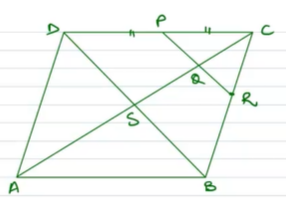In fig.22, ABC is right angled at A. Q and R are points on line BC and P is a point such that QP∣∣AC and RP∣∣AB . Find ∠P.
To solve the problem step by step, we will analyze the given triangle ABC and the relationships between the angles formed by the parallel lines.
Step 1: Understand the triangle and the angles
In triangle ABC, we know that angle A is a right angle (90 degrees). Thus, we can write:
∠A+∠B+∠C=180∘
Since ∠A=90∘:
90∘+∠B+∠C=180∘
This simplifies to:
∠B+∠C=90∘(Equation 1)
Step 2: Identify the relationships due to parallel lines
From the problem, we know:
- QP∥AC implies that ∠C=∠Q (alternate angles).
- RP∥AB implies that ∠B=∠R (alternate angles).
Step 3: Use the angle sum property in triangle PQR
In triangle PQR, we apply the angle sum property:
∠P+∠Q+∠R=180∘(Equation 2)
Substituting the angles we found in Step 2:
∠P+∠C+∠B=180∘
Step 4: Substitute Equation 1 into Equation 2
From Equation 1, we know that ∠B+∠C=90∘. We can substitute this into the equation from Step 3:
∠P+90∘=180∘
Step 5: Solve for angle P
Now, we can isolate ∠P:
∠P=180∘−90∘
∠P=90∘
Thus, the required angle ∠P is 90∘.
Summary of the solution:
The angle ∠P is 90∘.
---
In triangle ABC, we know that angle A is a right angle (90 degrees). Thus, we can write:
∠A+∠B+∠C=180∘
Since ∠A=90∘:
90∘+∠B+∠C=180∘
This simplifies to:
∠B+∠C=90∘(Equation 1)
From the problem, we know:
- QP∥AC implies that ∠C=∠Q (alternate angles).
- RP∥AB implies that ∠B=∠R (alternate angles).
In triangle PQR, we apply the angle sum property:
∠P+∠Q+∠R=180∘(Equation 2)
Substituting the angles we found in Step 2:
∠P+∠C+∠B=180∘
From Equation 1, we know that ∠B+∠C=90∘. We can substitute this into the equation from Step 3:
∠P+90∘=180∘
Now, we can isolate ∠P:
∠P=180∘−90∘
∠P=90∘
The angle ∠P is 90∘.
Topper's Solved these Questions
Similar Questions
Knowledge Check
The points P(a,b+c),Q(b,c+a) and R(c,a+b) are such that PQ = QR if
Aa, b, c are in A.P.Ba, b, c are in G.P.Ca, b, c are in H.P.Dnone of these
PQRS is a trapezium having PS a n d QR as parallel sides. A is any point on PQandB is a point on SR such that ABQR . If area of PBQ is 17cm2, find the area of ASR
View SolutionABCD is a trapezium in which ABDC . P and Q are points on sides AD and BC such that PQAB . If PD=18 , BQ=35 and QC=15 , find AD .
View SolutionIn Figure, ABCD is a parallelogram in which P is the mid-point of DC and Q is a point on AC such that CQ=14AC. If PQ produced meets BC at R. Prove that R is a mid-point of BC.

View SolutionIn Figure, ABCD is a parallelogram in which P is the mid-point of DC and Q is a point on AC such that CQ=14AC. If PQ produced meets BC at R, prove that R is a mid-point of BC
View SolutionIn Figure, ABCD and PQRC are rectangles and Q is the mid-point of AC . Prove that DP=PC (ii) PR=12 AC
View SolutionIn a triangle, P, Q and R are the mid-points of sides BC, CA and AB respectively. If AC=21 cm, BC=29cm and AB=30cm, find the perimeter of the quadrilateral ARPQ
View SolutionABC is a triangle, P is a point on ABandQ is a point on AC such that ∠AQP=∠ABC. Complete the relation AreaofAPQAreaofABC=.()AC2 .
View Solution
